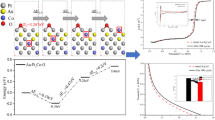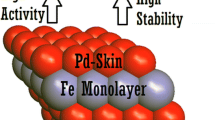Abstract
The long-term stability of Pt electrocatalyst during oxygen reduction reaction (ORR) is a great challenge hampering its use as the cathode of proton exchange membrane fuel cells for automobile applications. A number of researches have reported that the surface oxide formation by diffusion of the atomic oxygen to the sublayer is important to understand its stability. Here, we focused on the study of the effects of the O2-containing intermediates of ORR such as O2 and OOH toward the diffusion of the atomic oxygen in the Pt(111) surface by using the density functional theory calculations. Using the climbing image nudged elastic band method, we found that the energy barrier for the diffusion of O in both the forward and the backward directions decreases by the presence of O2 and OOH on the Pt(111) surface. The reduction of the energy barrier in the forward direction speeds up the diffusion of O into the subsurface and hence speeds up the surface oxide formation, while the reduction of the energy barrier in the backward direction triggers the atomic oxygen moving back to the on-surface that may destroy the Pt(111) surface and therefore affect the stability of the Pt(111) substrate. These results strongly support the previous experiments. Furthermore, the Bader charge analysis suggested that by simultaneously decreasing the charge gain of the atomic oxygen at the initial state (on the surface) and the final state (inside the subsurface) may help increase the stability of the Pt surface. Experiments such as using buffer solutions or corrosion inhibitors are suggested to confirm this prediction.
Graphical Abstract






Similar content being viewed by others
References
Markovic NM, Schmidt TJ, Stamenkovic V, Ross PN (2001) Oxygen reduction reaction on Pt and Pt bimetallic surfaces: a selective review. Fuel Cells 1:105–116
Yasuda K, Taniguchi A, Akita T, Ioroi T, Siroma Z (2006) Characteristics of a platinum black catalyst layer with regard to platinum dissolution phenomena in a membrane electrode assembly. J Electrochem Soc 153:A1599–A1603
Colon-Mercado HR, Popov BN (2005) Stability of platinum based alloy cathode catalysts in PEM fuel cells. J Power Sources 155:253–263
Blume R, Niehus H, Conrad H, Boettcher A, Aballe L, Gregoratti L, Barinov A, Kiskinova M (2005) Identification of subsurface oxygen species created during oxidation of Ru(0001). J Phys Chem B 109:14052–14058
Gattinoni C, Michaelides A (2015) Atomistic details of oxide surfaces and surface oxidation: the example of copper and its oxides. Surf Sci Rep 70:424–447
McMilan N, Lele T, Snively C, Lauterbach J (2005) Subsurface oxygen formation on Pt(100): experiments and modeling. Catal Today 105:244–253
Leisenberger FP, Koller G, Sock M, Surnev S, Ramsey MG, Netzer FP, Klotzer B, Hayek K (2000) Surface and subsurface oxygen on Pd(111). Surf Sci 445:380–393
Topalov AA, Katsounaros I, Auinger M, Cherevko S, Meier JC, Klemm SO, Mayrhofer KJJ (2012) Dissolution of platinum: limits for the deployment of electrochemical energy conversion? Angew Chem Int Ed 51:12613–12615
Matsumoto M, Miyazaki T, Imai H (2011) Oxygen-enhanced dissolution of platinum in acidic electrochemical environments. J Phys Chem C 115:11163–11169
Kongkanand A, Ziegelbauer JM (2012) Surface platinum electrooxidation in the presence of oxygen. J Phys Chem C 116:3684–3693
Paik CH, Jarvi TD, O’Grady WE (2004) Extent of PEMFC cathode surface oxidation by oxygen and water measured by CV. Electrochem Solid State Lett 7:A82–A84
Darling RM, Meyers JP (2003) Kinetic model of platinum dissolution in PEMFCs. J Electrochem Soc 150:A1523–A1527
Xu Y, Greeley J, Mavrikakis M (2005) Effect of subsurface oxygen on the reactivity of the Ag(111) surface. J Am Chem Soc 127:12823–12827
Rotermund HH, Pollmann M, Kevrekidis IG (2002) Pattern formation during the CO-oxidation involving subsurface oxygen. Chaos 12:157–163
Reddy AKN, Genshaw MA, Bockris JO’M (1968) Ellipsometric study of oxygen-containing films on platinum anodes. J Chem Phys 48:671–675
Wagner FT, Ross PN Jr (1985) LEED spot profile analysis of the structure of electrochemically treated Pt(100) and Pt(111) surfaces. Surf Sci 160:305–330
Chu YS, You H, Tanzer JA, Lister TE, Nagy Z (1999) Surface resonance X-ray scattering observation of core-electron binding-energy shifts of Pt(111)-surface atoms during electrochemical oxidation. Phys Rev Lett 83:552–555
Nagy Z, You H (2002) Applications of surface X-ray scattering to electrochemistry problems. Electrochim Acta 47:3037–3055
Jerkiewicz G, Vatankhah G, Lessard J, Soriaga MP, Park Y-S (2004) Surface-oxide growth at platinum electrodes in aqueous H2SO4: reexamination of its mechanism through combined cyclic-voltammetry, electrochemical quartz-crystal nanobalance, and auger electron spectroscopy measurements. Electrochim Acta 49:1451–1459
Gu Z, Balbuena PB (2007) Absorption of atomic oxygen into subsurfaces of Pt(100) and Pt(111): density functional theory study. J Phys Chem C 111:9877–9883
Gu Z, Balbuena PB (2007) Chemical environment effects on the atomic oxygen absorption into Pt(111) subsurfaces. J Phys Chem C 111:17388–17396
Li WX, Stampfl C, Scheffler M (2003) Subsurface oxygen and surface oxide formation at Ag(111): a density-functional theory investigation. Phys Rev B 67:045408
Legare P (2005) Interaction of oxygen with the Pt(111) surface in wide conditions range. A DFT-based thermodynamical simulation. Surf Sci 580:137–144
Todorova M, Reuter K, Scheffler M (2005) Density-functional theory study of the initial oxygen incorporation in Pd(111). Phys Rev B 71:195403
Son DN, Nakanishi H, David MY, Kasai H (2009) Oxygen reduction on Pt(111) cathode of fuel cells. J Phys Soc Jpn 78:114601
Son DN, Cong BT, Kasai H (2011) Hydronium adsorption on OOH precovered Pt(111) surface: effects of electrode potential. J Nanosci Nanotechnol 11:2983–2989
Wroblowa HS, Pan YC, Razumney G (1976) Electroreduction of oxygen a new mechanistic criterion. J Electroanal Chem 69:195–201
Markovic NM, Ross PN (2002) Surface science studies of model fuel cell electrocatalysts. Surf Sci Rep 45:117–229
Strabac S, Anastasijevic NA, Adzic RR (1994) Oxygen reduction on Au(111) and vicinal Au(332) faces: a rotating disc and disc-ring study. Electrochim Acta 39:983–990
Stamenkovic V, Mun BS, Mayrhofer KJJ, Ross PN, Markovic NM, Rossmeisl J, Greeley J, Nørskov JK (2006) Changing the activity of electrocatalysts for oxygen reduction by tuning the surface electronic structure. Angew Chem 118:2963–2967
Yotsuhashi S, Yamada Y, Diño WA, Nakanishi H, Kasai H (2005) Dependence of oxygen dissociative adsorption on platinum surface structures. Phys Rev B 72:033415
Henkelman G, Jonsson H (2000) Improved tangent estimate in the nudged elastic band method for finding minimum energy paths and saddle points. J Chem Phys 113:9978–9985
Henkelman G, Uberuaga BP, Jonsson H (2000) A climbing image nudged elastic band method for finding saddle points and minimum energy paths. J Chem Phys 113:9901–9904
Jonsson H, Mills G, Jacobsen KW (1998) Nudged elastic band method for finding minimum energy paths of transitions. In: Berne BJ, Cicotti G, Coker DF (eds) Classical and quantum dynamics in condensed phase simulation. World Scientific, Singapore, p 385
Branger V, Pelosin V, Badawi KF, Goudeau P (1996) Study of the mechanical and microstructural state of platinum thin films. Thin Solid Films 275:22–24
Perdew JP, Chevary JA, Vosko SH, Jackson KA, Pederson MR, Singh DJ, Fiolhais C (1992) Atoms, molecules, solids, and surfaces: applications of the generalized gradient approximation for exchange and correlation. Phys Rev B 46:6671–6687
Perdew JP, Burke K, Ernzerhof M (1996) Generalized gradient approximation made simple. Phys Rev Lett 77:3865–3868
Blochl PE (1994) Projector augmented-wave method. Phys Rev B 50:17953–17979
Kresse G, Joubert J (1999) From ultrasoft pseudopotentials to the projector augmented-wave method. Phys Rev B 59:1758–1775
Monkhorst HJ, Pack JD (1976) Special points for Brillouin-zone integrations. Phys Rev B 13:5188–5192
Neugebauer J, Scheffler M (1992) Adsorbate-substrate and adsorbate-adsorbate interactions of Na and K adlayers on Al (111). Phys Rev B 46:16067–16080
Bengtsson L (1999) Dipole correction for surface supercell calculations. Phys Rev B 59:12301–12304
Methfessel M, Paxton AT (1989) High-precision sampling for Brillouin-zone integration in metals. Phys Rev B 40:3616–3621
Blöchl PE, Jepsen O, Andersen OK (1994) Improved tetrahedron method for Brillouin-zone integrations. Phys Rev B 49:16223–16233
Tang W, Sanville E, Henkelman G (2009) A grid-based bader analysis algorithm without lattice bias. J Phys 21:084204
Sanville E, Kenny SD, Smith R, Henkelman G (2007) An improved grid-based algorithm for bader charge allocation. J Comp Chem 28:899–908
Henkelman G, Arnaldsson A, Jónsson H (2006) A fast and robust algorithm for bader decomposition of charge density. Comput Mater Sci 36:254–360
Son DN, Takahashi K (2012) Selectivity of palladium–cobalt surface alloy toward oxygen reduction reaction. J Phys Chem C 116:6200–6207
Son DN, Le OK, Chihaia V, Takahashi K (2015) Effects of Co content in Pd-skin/PdCo alloys for oxygen reduction reaction: density functional theory predictions. J Phys Chem C 119:24364–24372
Yeo YY, Vattuone L, King DA (1997) Calorimetric heats for CO and oxygen adsorption and for the catalytic CO oxidation reaction on Pt{111}. J Chem Phys 106:392–401
Menezes PW, Indra A, González-Flores D, Sahraie NR, Zaharieva I, Schwarze M, Strasser P, Dau H, Driess M (2015) High-performance oxygen redox catalysis with multifunctional cobalt oxide nanochains: morphology-dependent activity. ACS Catal 5:2017–2027
Watson VJ, Delgado CN, Logan BE (2013) Improvement of activated carbons as oxygen reduction catalysts in neutral solutions by ammonia gas treatment and their performance in microbial fuel cells. J Power Sources 242:756–761
Finšgar M, Jackson J (2014) Application of corrosion inhibitors for steels in acidic media for the oil and gas industry: a review. Corros Sci 86:17–41
Rani BEA, Basu BBJ (2012) Green inhibitors for corrosion protection of metals and alloys: an overview. Int J Corros 2012:380217. doi:10.1155/2012/380217
Pasti IA, Skorodumova NV, Mentus SV (2015) Theoretical studies in catalysis and electrocatalysis: from fundamental knowledge to catalyst design. React Kinet Mech Catal 115:5–32
Li Y, Xu H, Zhao H, Lu L, Sun X (2016) Improving the durability of Pt/C catalyst in PEM fuel cell by doping vanadium phosphate oxygen. J Appl Electrochem 46:183–189
Ordóñez LC, Escobar B, Barbosa R, Verde-Gómez Y (2015) Enhanced performance of direct ethanol fuel cell using Pt/MWCNTs as anodic electrocatalyst. J Appl Electrochem 45:1205–1210
Antolini E (2004) Recent developments in polymer electrolyte fuel cell electrodes. J Appl Electrochem 34:563–576
Acknowledgments
This research was funded by the Vietnam National Foundation for Science and Technology Development (NAFOSTED) under grant number 103.01-2013.74. K. Takahashi thanks Academia Sinica and National Center for High Performance Computing of Taiwan for the usage of supercomputer system.
Author information
Authors and Affiliations
Corresponding author
Electronic supplementary material
Below is the link to the electronic supplementary material.
Rights and permissions
About this article
Cite this article
Son, D.N., Gam, N.T. & Takahashi, K. Ab-initio study of surface oxide formation in Pt(111) electrocatalyst under influences of O2-containing intermediates of oxygen reduction reaction. J Appl Electrochem 46, 1031–1038 (2016). https://doi.org/10.1007/s10800-016-0982-9
Received:
Accepted:
Published:
Issue Date:
DOI: https://doi.org/10.1007/s10800-016-0982-9




